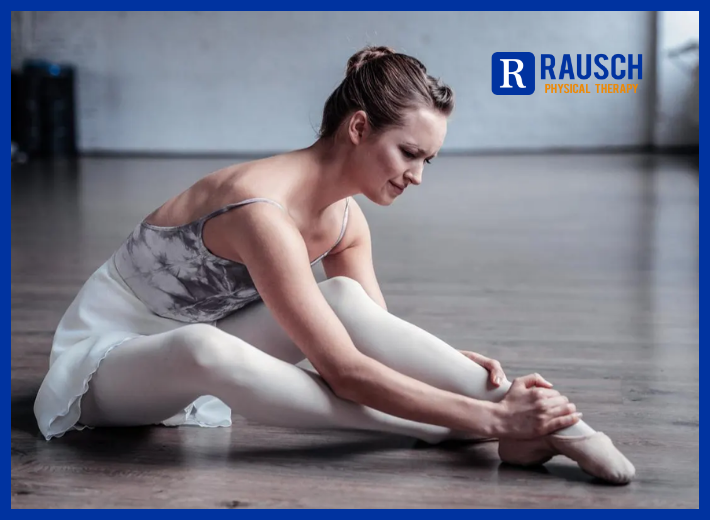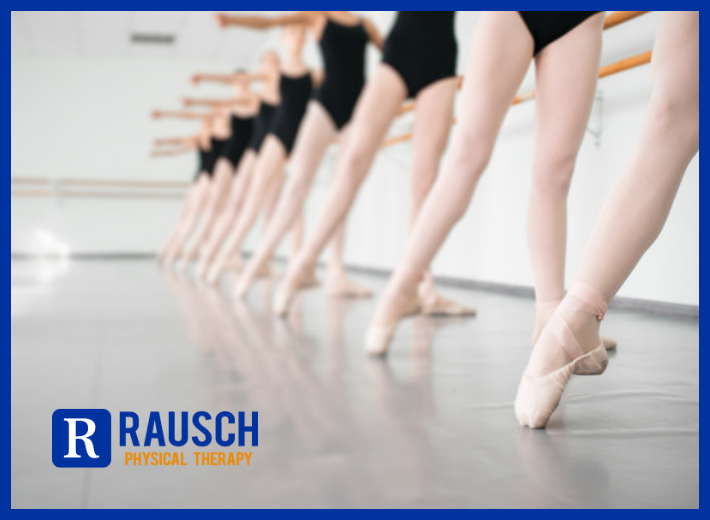When it comes to sports, staying healthy is just as important as playing hard. A serious injury can knock you out of the game for weeks—or even months—whether you’re a,
Preventing Dance-Related Injuries
November 1, 2023 4:00 pm / Category: Laguna Niguel

Dancers put their bodies through incredible feats of strength, agility, and flexibility. However, these demanding movements can also lead to a variety of injuries. As PTs, we understand the importance of maintaining peak performance while staying injury-free. Take a look at our valuable insights into prevention strategies and techniques to help dancers recover and thrive.
Dance may look effortless, but it requires a lot of strength, flexibility and stamina. It also comes with a high risk of injuries. Whether you are a dancer, the parent of a dancer or a dance teacher, you should be aware of the most common dance injuries and learn how to avoid them.
Johns Hopkins performing arts physical therapists Andrea Lasner and Amanda Greene share valuable information about dance injury treatments and prevention tips. Lasner and Greene, both dancers, have turned their love for the art into a means of helping injured dancers.
What are some common dance injuries?
A few studies that looked into dance injuries found that injuries from using your joints and muscles too much (overuse injuries) are the most common in dancers. The majority of these overuse injuries involve an ankle, leg, foot or lower back. Some common dance injuries are:
- Hip injuries: snapping hip syndrome, hip impingement, labral tears, hip flexor tendonitis, hip bursitis and sacroiliac joint dysfunction
- Foot and ankle injuries: Achilles tendonitis, trigger toe and ankle impingement
- Knee injuries: patellofemoral pain syndrome
- Stress fractures: metatarsals, tibia, sesamoids and lumbar spine
- Dancers are also likely to develop arthritis in the knee, hip, ankle and foot
Generally, dancers have a much lower rate of anterior cruciate ligament (ACL) injuries than other athletes. One explanation could be that dance training involves much more intense jumping from an earlier age than other sports, which helps improve muscle control.
How do I know if the pain is from an injury?
In most cases, the pain you experience after dancing is muscle soreness that usually subsides within 24 to 48 hours. Sometimes, it takes a few days for muscles to get sore, which is also normal. However, if you experience the following types of pain, you may have suffered an injury:
- Pain that wakes you up at night
- Pain that is present at the start of an activity
- Pain that increases with an activity
- Pain that makes you shift your weight or otherwise compensate your movements
If you experience such pain, consult with a medical specialist — preferably a physical therapist or physician with experience in treating dancers. They will be able to determine whether additional testing is needed and will formulate an appropriate treatment plan.
Why do dance injuries happen?
Dance is a physically demanding activity. Dancers perform repetitive movements for several hours a day. Studies have shown that dancing five hours a day or longer leads to an increased risk of stress fractures and other injuries.
On top of the intensive training, many dancers get little time to recover between the sessions and have no “offseason.” Restrictive diets and unhealthy body weights may also contribute to dance injuries. Proper nutrition is important for dancers of all ages.
How do dancers get ankle sprains?
Ankle sprains are the number one traumatic injury in dancers. Traumatic injuries are different from overuse injuries as they happen unexpectedly. When an ankle is sprained, ligaments on the inside or outside of your foot get twisted or overstretched and may experience tears. Ankle sprains often happen due to improper landing from a jump, misaligned ankles (when they roll in or out) or poorly fitted shoes. Torn ligaments never heal to their preinjury condition. Once you’ve sprained your ankle, you are at risk of doing it again. It’s important to build muscle strength to prevent further injuries.
Dance Injury Prevention
How can dance injuries be prevented?
The majority of overuse injuries and even some traumatic dance injuries can be prevented. Follow these guidelines to reduce your risk of injury:
- Eat well and stay hydrated before, during and after class.
- Get enough rest and avoid overtraining.
- Do cross-training exercises to build strength and endurance in all parts of your body.
- Always wear proper shoes and attire.
- Always warm-up before training or performances.
- Lead a healthy lifestyle and get to know your body.
When injuries happen, address them immediately and get advice from a doctor or physical therapist.
What are good cross-training exercises for dancers?
Core and hip strengthening exercises like Pilates and stability-based yoga are great for dancers. And so are aerobic and cardiovascular activities, such as running, swimming or biking. They get your heart rate up and help build stamina for long performances.
Many dancers don’t do enough cardio during their regular training. Just 30 minutes three to four times a week is usually enough to improve your endurance. As always, do this in moderation and in short intervals to avoid stressing your joints. Being screened by a physical therapist with experience treating dancers will help you identify individual areas of weakness to address with specific exercises.
How much rest should a dancer get?
While many experts stress the importance of proper rest, there are no specific guidelines on the frequency and amount of rest. However, we know that dancing five hours a day or longer is linked to an increased risk of injury. It is also known that intense activity leads to microdamage, which peaks in recovery 12 to 14 hours after a workout. So it would make sense to take the next day off after a high-intensity activity. Dancers should work at their highest intensity a couple of times per week and then take at least two days off, preferably in a row. Also, a three- to four-week period of rest after the season is ideal for recovery.
Dance Injury Treatment
Should I ice or heat after a dance injury?
If it’s a sudden injury, it’s best to apply ice first to reduce swelling and inflammation. RICE treatment is a common approach that involves rest, ice, compression and elevation. After a few days, you can switch to heat to increase blood flow to the area and promote healing. However, every person is different. If you feel that ice helps you better than heat, then there is nothing wrong with continuing to ice. But be careful not to ice before dancing or stretching, because you want those muscles to be warmed up to prevent re-injury.
What are my treatment options for a dance injury?
It depends on the type of injury, your level as a dancer and many other factors. For example, for traumatic injuries like ankle sprains, your doctor may recommend RICE, joint protection and physical therapy. For stress fractures you may need to limit weight on your foot by using crutches, wearing a leg brace or walking boots. Surgery is typically used as the last resort. It is best to discuss your treatment options with a doctor who specializes in dance injuries. And if you are working with a physical therapist, make sure he or she is experienced in treating dancers. A big part of physical therapy is correcting the training technique that led to the injury. Otherwise, you risk hurting yourself again by making the same mistake.
What should be in the first aid kit for dance injuries?
Your regular first aid kit might already have many of the essentials for handling a medical emergency. However, when it comes to common dance injuries, you may want to include a few additional items, such as:
- Instant cold pack
- Pre-wrap and athletic tape (if qualified providers are available to apply)
- Elastic bandages (to be used only for compression, not support while dancing)
- Crutches
- Topical pain reliever
Rausch PT is here to help you achieve your best performance. Our personalized PT programs can keep you moving with grace and confidence. Don’t let injuries steal the spotlight. Contact us today at 949-597-0007. You can follow us on TikTok and Instagram for more inspiration and tips.






